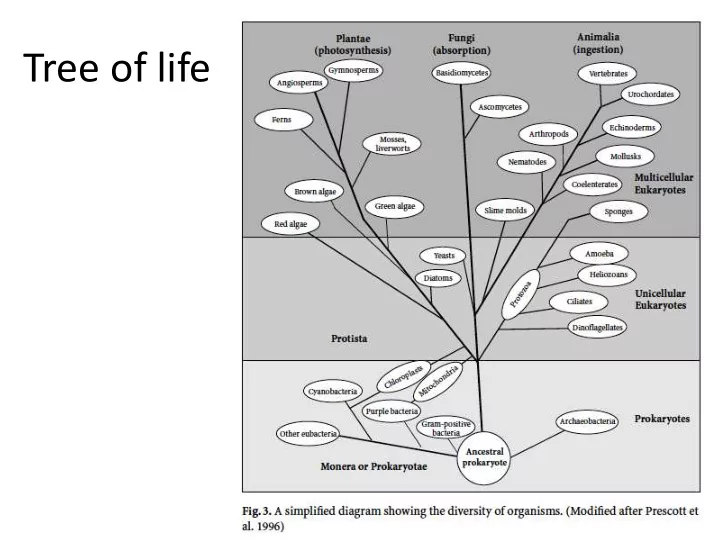

Tree of life
Microbial Diversity
Nutritional diversity
Soil bacteria Schizomycetes Myxobacteria • Genus • Orders – Myxococcus – Pseudomonas – Chondrococcus – Eubacteria – Archangium – Polyangium – Actinomycetes – Cytophaga – Sporocytophaga • “Bacteria” • 10 7 -10 9 /g soil • “Swarm” • consume insoluble • 10 6 /ml water organics • Intercellular “communication”
Soil archaebacteria
Soil fungus
Eukaryotes + Prokaryote
Introduction • What are soils? • What are the general processes involved? • How to microorganisms (and plants) contribute?
Rock weathering & decay • Primary material must be broken down to smaller pieces – Increased surface area/volume ratio – Increased binding of nutrients – Release/binding of metals – Niche formation / chemical gradients
Soil texture • Sand v. clay • Porosity and retention – Microorganisms – Air (aeration) – Moisture – Surface Area • Influences?
Minerals
Microbial processes Epilithic lichens • Mechanism – Physical (rhizine penetration) – Chemical (lichen-organic acids) – Crustose cover undergoes differential wetting and drying (and heat transfer) • Results – Grain detachment – Detachment by fractional heating
Microbial processes Epilithic free living algae • Mechanisms – Photosynthesis / alkalinisation of rock surfaces – Extracellular polymeric substances (EPS) • Results – Dissolution of rock – Protective surface biofilm
Microbial processes Chasmolithic and endolithic cyanobacteria, algae, chemo- organotrophic bacteria and fungi • Mechanisms – Physical (swelling) – Chemical (acids, polysaccharides) through EPS – Differential heating due to pigments (melanins) – Turgor pressure • Results – Exfoliation, chipping, pitting – Increased porosity – Surface parallel cracking
Microbial processes • Ideas of biological attack – Photosynthesis (alkalinisation) by algae and lichens – Chemolithotrophic organisms (e.g …) • Sulfate oxidising bacteria (sulfuric acid) • Ammonia oxidising bacteria (nitric acid) – Heterotrophic bacteria • Consumption of organics • Production of CO 2 (CO 2 + H 2 O = H 2 CO 3 )
Organics
Organics - terminology
Organic matter Mineralisation Partial decomposition • • Formation of complex Complete breakdown into inorganic components organic radicals • Polymerisation humus – Carbon dioxide – Nitrate / ammonia – Sulfate • Humus – Phosphate – Small % of soil • Fate – (+) water capacity – Re-mobilised by biota – (+) aggregation – Redox changes – (+) negative charge – Gas transformation – Leach through pores – (+) soil fertility – Sorb on to particles
Organic matter • Plant litter most organic matter • Some exceptions – Lichens – Cyanobacteria – Fungi • Some other bacteria that produce biomass from CO 2 (inorganic C) • Assimilated (biomass) / partly mineralised
Plant compounds Storage materials (intracellular) • Proteins • Starch • Sugars • Chlorophyll • Pigments
Plant compounds Structural materials • Cellulose • Hemicelluloses (polysaccharides that surround fibres) • Lignins (stabilisers) • Tannins (chemical defenses)
Plant materials Storage materials (intracellular) • Easily broken down and assimilated.
Other compounds Microbial compounds Black carbon
Humification
Humification • Factors affecting decomposition – Water potential – Oxygen supply – Temperature – Nutrients – pH
Humification • Complex process – Plant products degradable products monomers microbial biomass – Plant products un-degradable (incl. slow) products re-assembled – oxidized to humic precursors (humic and fulveric acids) – complexation with clays and metal hydroxides • Truthfully, very little is known of the process (esp. “rapid re-synthesis of microbial biomass to polysaccharide and proteinaceous moeities in the humic fractions)”
Organic matter and humus • Affects coexistence of plants, animals and microbes • Regulate nutrient flux to microbes • Hormonal role to plants • (+) cation exchange capacity • Buffer pH • (+) water capacity • Dark colour helps warm soil
Soil aggregation AZ Master Gardener, ag.arizona.edu
Soil aggregation • Benefits of aggregate abundance and stability – Plant growth – Resistance to erosion – Soil organic matter turnover – Organism (incl. mesofauna and microfauna) abundance, activity and diversity
Microbial metabolites • Polysaccharides – Root exudates - carbohydrates – Bacterial EPS – polysaccharides, proteins, nucleic acids • Glomalin – Abruscular mycorrhyzal fungi – Recalcitrant – Insoluble to water • Lipids
Biofilms
Microbial methods to improve soil aggregation • Rhisophere microbial communities • Organic residues • Inoculation with microorganism • Calcite-forming bacteria (bio-cementation)
Recommend
More recommend